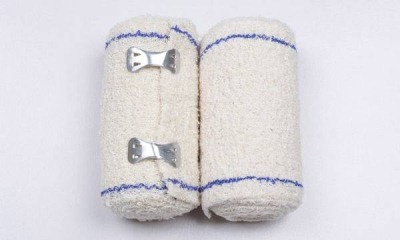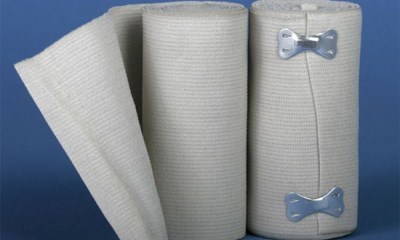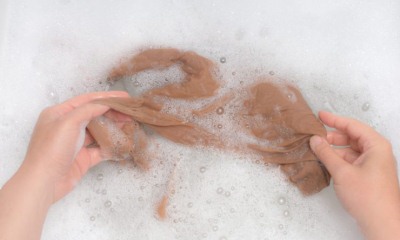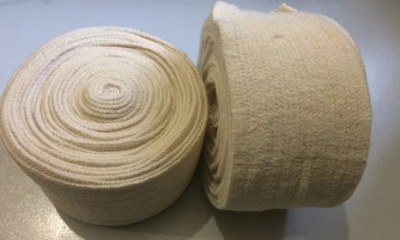Useful tips on how to wash an elastic bandage so that it does not lose its properties
 A dressing material such as an elastic bandage has a long service life, which makes it different from gauze.
A dressing material such as an elastic bandage has a long service life, which makes it different from gauze.
Therefore, due to frequent use, it needs proper care. This is especially true for washing. Otherwise, it quickly loses its original properties and becomes unusable.
Is it possible and how to properly wash an elastic bandage in a washing machine and by hand, we will tell in the article.
Content
Can they be washed?
 Compression elastic bandage is a stretchable tape designed to fix dressings and joints in case of ligament injury:
Compression elastic bandage is a stretchable tape designed to fix dressings and joints in case of ligament injury:
- stretching,
- dislocation,
- break.
In addition, it is used for varicose veins to evenly distribute pressure on the legs. According to the type of material, it can be synthetic and cotton... The first option is mainly used by athletes, as it is stronger and less wears out.
These bandages are easier to wash and dry. But they are not designed for extended wear. On an ongoing basis, it is better to use the second option, since cotton does not irritate the skin with prolonged contact.
Synthetic made from rubber, polyurethane or paper... To give elasticity to products, the fabric includes:
- latex,
- lycra,
- rubber.
More precise composition can be found on the label. If the doctor has prescribed the constant wearing of a bandage, then it is preferable to choose one that is cotton-based.
The rubber structure of the elastic bandages allows them to be used for a long period, but subject to proper washing. It is advisable to wash such products by hand. Machine wash is also allowed, but at a low temperature, on a delicate cycle and without spinning.
These bandages become unusable when exposed to high temperatures, so they cannot be ironed or washed at high temperatures. And also boiling is not allowed.
Choice of detergents
 Care should be taken to select detergents for washing.You should take only those specially designed for this - ordinary washing powder will not work.
Care should be taken to select detergents for washing.You should take only those specially designed for this - ordinary washing powder will not work.
This is due to the following reasons:
- the powder partially remains in the fibers of the fabric, without being washed out completely due to the low-temperature washing mode;
- presence in the composition of aggressive elements that have a destructive effect on rubber.
As a result, the bandage loses its elasticity and it will no longer be possible to use it for its intended purpose.
True, when washing in an automatic machine, it is permissible to add a little ordinary washing powder. But with the manual method of washing it is necessary to choose softer and more environmentally friendly detergents - gel and liquid. Laundry soap will also work.
If you are prone to allergies, it is recommended to use high-quality expensive detergents and rinses. And for a complete leveling of chemistry from the fabric, soak the bandage for 2 hours in cold water before rinsing.
How to treat in a washing machine?
To understand whether it is possible to wash a bandage of a specific model in a washing machine, you need to look at the manufacturer's tag - there are recommendations for care.
Only a number of conditions are observed:
 Before putting it into the drum, the bandage is rolled into a coil and placed in a special mesh bag for washing. Do not put it disassembled and crumpled.
Before putting it into the drum, the bandage is rolled into a coil and placed in a special mesh bag for washing. Do not put it disassembled and crumpled.- Set the "Delicate" or "Hand wash" mode and the temperature no more than 30 ᵒС. This is so that the bandage does not lose its original values.
- A liquid detergent is poured into the cuvette so as not to harm the tissue structure. In addition, it removes dirt better and is completely washed out by rinsing. It is not recommended to add conditioners.
In the presence of the "Spin" function, it is immediately turned off. Otherwise it will stretch and break the rubber threads in the fabric. Do not put an elastic bandage with other things in the washing machine.
The video will tell you how to wash an elastic bandage in a washing machine:
How to hand wash properly?
It is important to wash it correctly to prolong the life of the elastic bandage. It is preferable to do it manually.
In this case, a number of points are taken into account:
 pre-soak the product in soapy water and wait 10-15 minutes;
pre-soak the product in soapy water and wait 10-15 minutes;- wash exclusively in cool water - approximate temperature 30-40 ᵒС;
- it is not advisable to use standard powdered products, conditioners and other water softeners;
- do not rub the bandage hard in your hands, so as not to damage the elastic structure of the material;
- when rinsing, the product is not stretched or twisted so that it does not deform;
- do not twist strongly during spinning - just squeeze slightly in your hand.
So that excess moisture comes out of the bandage, they do not hang it on a rope, but act differently: they put it in a towel and squeeze it.
Possible mistakes and ways to avoid them
Common washing mistakes elastic bandage:
- They are often washed. It is recommended to do this as soon as it gets dirty, without once again exposing the fragile structure of the fabric to the aggressive effects of chemical detergents. But it is also impossible to tighten with washing, which will lead to drying out and rupture of rubber threads.
- Use hot water for washing or soaking. The optimal temperature regime for water should be in the range of 30-40 ᵒС.
- They use free-flowing powders and rinses.
- The bandage is pre-lathered. This should not be done, but it is better to first dissolve the detergent composition in water and foam.
- Rub the fabric too intensively during washing, and then wring it out by twisting.
- Wash in a typewriter under normal conditions, followed by spinning at high speeds.
How to fix the consequences of improper cleaning?
 The standard service life of an elastic bandage is 5-6 months. But if washed incorrectly, it can quickly lose its original characteristics.
The standard service life of an elastic bandage is 5-6 months. But if washed incorrectly, it can quickly lose its original characteristics.
This happens as a result:
- loss of tissue density;
- rupture of rubber, which leads to a loss of elasticity;
- changes in presentation.
In such a situation, the product can no longer be used for medicinal purposes. It is unacceptable to apply a bandage that has lost the required extensibility.
This can lead to constriction of blood vessels and blockage of tissue nutrition.... This not only will not have a preventive effect, but will also lead to serious pathology. Since the bandage cannot be restored, they acquire a new one.
If the care rules were followed, and the bandage deteriorated after the first wash, then it is recommended to change the brand in the future.
How to dry?
After rinsing, the product must not be twisted so that water flows out of it.... Do not iron it with a hot iron yet to speed up the drying process.
As already mentioned, it is unacceptable to dry an elastic bandage under the influence of direct sunlight and on heating appliances. They also do not hang it on a clothesline, otherwise it will stretch under the weight of the water.
Conclusion
These simple washing methods can be applied to a variety of compression garments. (bandages, belts, corsets, tights, knee-highs). They are made from a similar fabric. If you adhere to these elementary rules, then the bandage will last the period specified by the manufacturer.



 Cleaning
Cleaning Wash
Wash Ironing
Ironing Technics
Technics Cleaning products
Cleaning products Storage and care
Storage and care